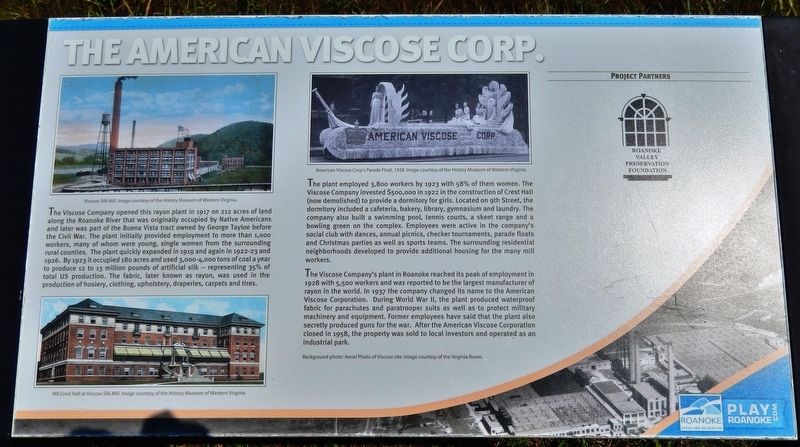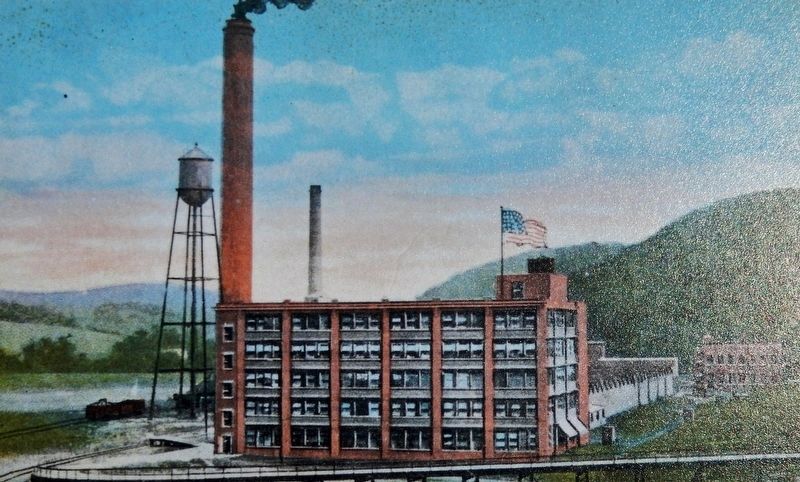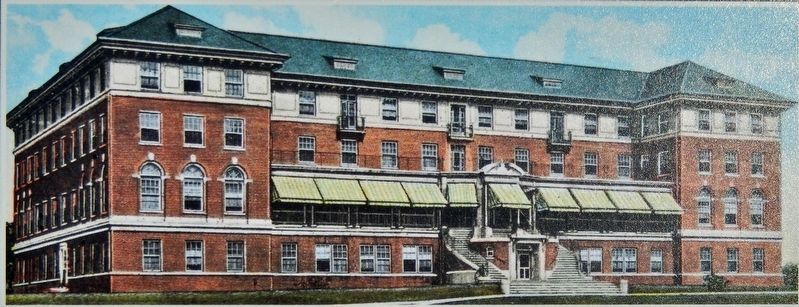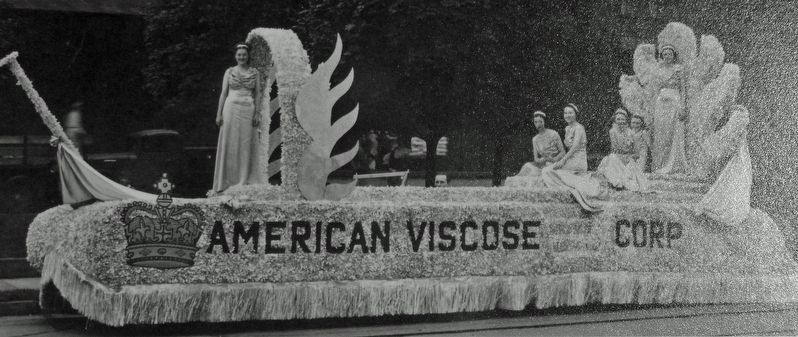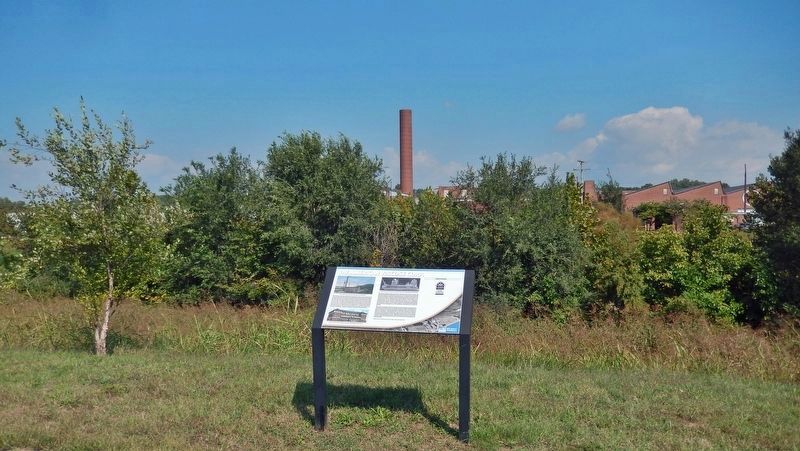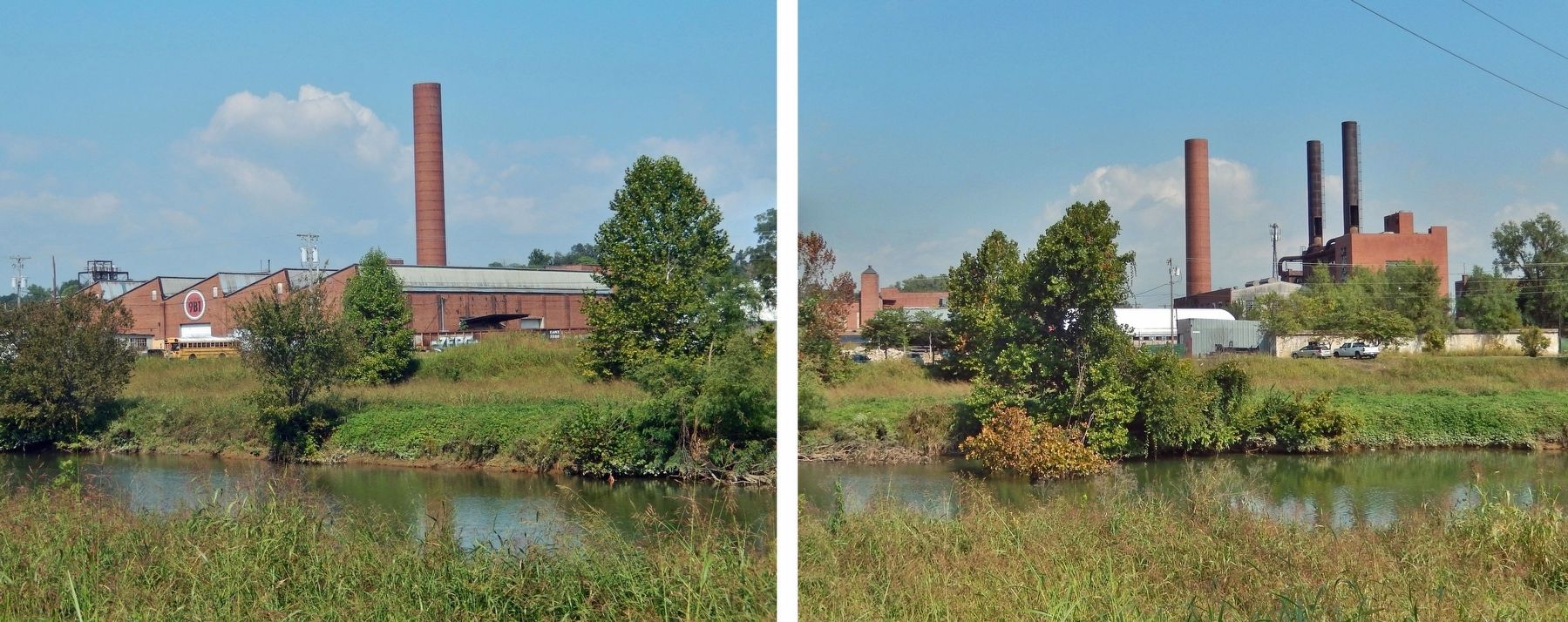Roanoke, Virginia — The American South (Mid-Atlantic)
American Viscose Corp.
The Viscose Company opened this rayon plant in 1917 on 212 acres of land along the Roanoke River that was originally occupied by Native Americans and later was part of the Buena Vista tract owned by George Tayloe before the Civil War. The plant initially provided employment to more than 1,000 workers, many of whom were young, single women from the surrounding rural counties. The plant quickly expanded in 1919 and again in 1922-23 and 1926. By 1923 it occupied 180 acres and used 3,000-4,000 tons of coal a year to produce 12 to 13 million pounds of artificial silk — representing 35% of total US production. The fabric, later known as rayon, was used in the production of hosiery, clothing, upholstery, draperies, carpets and tires.
The plant employed 3,800 workers by 1923 with 58% of them women. The Viscose Company invested $500,000 in 1922 in the construction of Crest Halt (now demolished) to provide a dormitory for girls. Located on 9th Street, the dormitory included a cafeteria, bakery, library, gymnasium and laundry. The company also built a swimming pool, tennis courts, a skeet range and a bowling green on the complex. Employees were active in the company's social club with dances, annual picnics, checker tournaments, parade floats and Christmas parties as well as sports teams. The surrounding residential neighborhoods developed to provide additional housing for the many mill workers.
The Viscose Company's plant in Roanoke reached its peak of employment in 1928 with 5,500 workers and was reported to be the largest manufacturer of rayon in the world. In 1937 the company changed its name to the American Viscose Corporation. During World War II, the plant produced waterproof fabric for parachutes and paratrooper suits as well as to protect military machinery and equipment. Former employees have said that the plant also secretly produced guns for the war. After the American Viscose Corporation closed in 1958, the property was sold to local investors and operated as an industrial park.
Background photo: Aerial Photo of Viscose site. Image courtesy of the Virginia Room.
Erected by Roanoke Parks and Recreation; and Roanoke Valley Preservation Foundation.
Topics. This historical marker is listed in these topic lists: Industry & Commerce • Native Americans • War, World II • Women. A significant historical year for this entry is 1917.
Location. 37° 15.102′ N, 79° 55.35′ W. Marker is in Roanoke, Virginia. Marker is on Roanoke River Greenway (at milepost 25.5), just east of Deaton Road Southeast, on the left when traveling east. Touch for map. Marker is in this post office area: Roanoke VA 24014, United States of America. Touch for directions.
Other nearby markers. At least 8 other markers are within 2 miles of this marker, measured as the crow flies. Endangered Species: The Roanoke Logperch (approx. 0.4 miles away); The Roanoke Star (approx. 0.6 miles away); Buzzard Rock Native American Settlement (approx. 0.9 miles away); The Virginian Railway Roanoke Passenger Station (approx. 1.2 miles away); Virginian Railway Station (approx. 1.2 miles away); History of Evan Mill and Crystal Spring (approx. 1.2 miles away); Big Lick Presbyterian Church (approx. 1.3 miles away); The Great Roanoke Fair & Mountain Park (approx. 1.3 miles away). Touch for a list and map of all markers in Roanoke.
More about this marker. Marker can be accessed via foot or bicycle on the Roanoke River Greenway.
Also see . . .
1. The American Viscose Company.
English chemist Charles Frederick Cross and his collaborators, Edward John Bevan and Clayton Beadle, patented their version of artificial silk in 1894. The material was named “viscose” because its production involved the intermediacy of a highly viscous solution. The viscose artificial silk process was commercialized in England by Samuel Courtald & Company in 1905. In 1909, Courtaulds formed a new subsidiary, the American Viscose Company.(Submitted on January 29, 2022, by Cosmos Mariner of Cape Canaveral, Florida.)
2. American Viscose Corporation.
American Viscose Corporation was an American division of the British firm Courtaulds, which manufactured rayon and other synthetic fibers. Established in 1909, it became the largest supplier of rayon and the first company to make artificial silk in the United States. American Viscose had plants at Marcus Hook, Pennsylvania (established 1910), Roanoke, Virginia (1916), Lewistown, Pennsylvania (1920), Parkersburg, West Virginia (1927), Meadville, Pennsylvania (1929), Nitro, West Virginia, and Front Royal, Virginia (1940).(Submitted on January 29, 2022, by Cosmos Mariner of Cape Canaveral, Florida.)
Credits. This page was last revised on February 1, 2023. It was originally submitted on January 28, 2022, by Cosmos Mariner of Cape Canaveral, Florida. This page has been viewed 1,337 times since then and 227 times this year. Photos: 1, 2, 3, 4, 5. submitted on January 28, 2022, by Cosmos Mariner of Cape Canaveral, Florida. 6. submitted on January 29, 2022, by Cosmos Mariner of Cape Canaveral, Florida.
